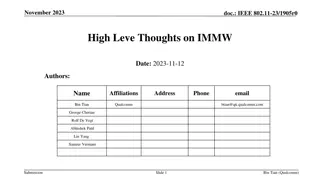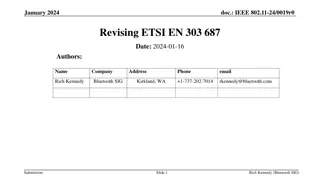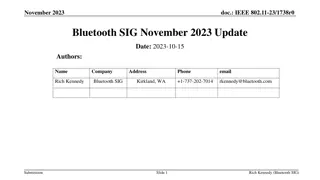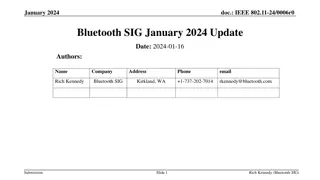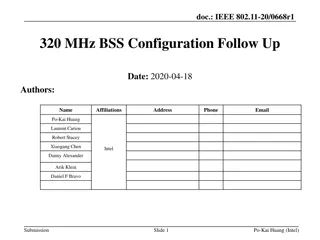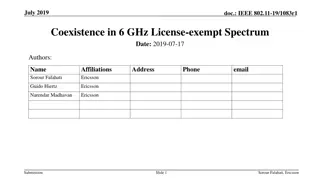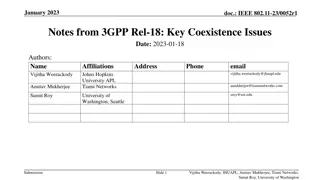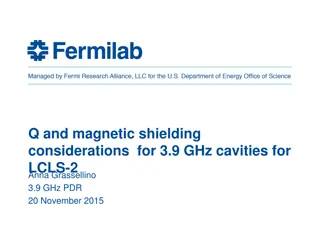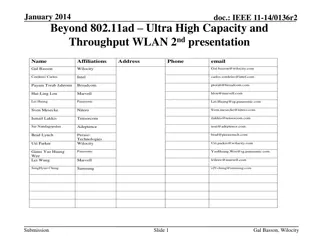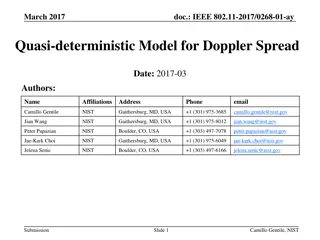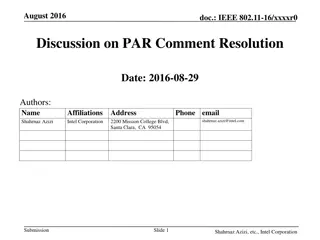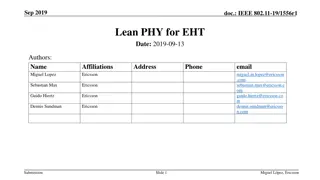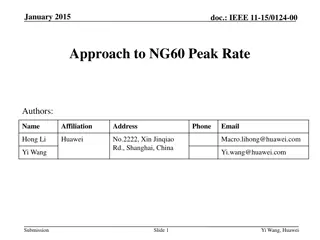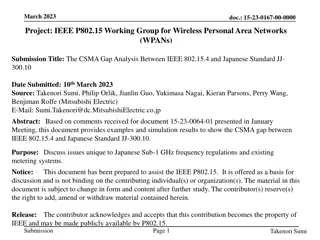6 GHz Principles
This document, authored by Brian Hart, David Kloper, Andrew Myles, Peter Ecclesine, Pooya Monajemi, and Mukesh Taneja of Cisco Systems, delves into the IEEE 802.11-18/1897r06 GHz principles as of November 2018. It provides insights and technical details on the topic, offering a valuable resource for those interested in this area of study.
Download Presentation

Please find below an Image/Link to download the presentation.
The content on the website is provided AS IS for your information and personal use only. It may not be sold, licensed, or shared on other websites without obtaining consent from the author.If you encounter any issues during the download, it is possible that the publisher has removed the file from their server.
You are allowed to download the files provided on this website for personal or commercial use, subject to the condition that they are used lawfully. All files are the property of their respective owners.
The content on the website is provided AS IS for your information and personal use only. It may not be sold, licensed, or shared on other websites without obtaining consent from the author.
E N D
Presentation Transcript
Nov 2018 doc.: IEEE 802.11-18/1897r0 6 GHz Principles Date: 2018-11-02 Authors: Name Affiliations Address Phone email Brian Hart David Kloper Andrew Myles Peter Ecclesine Pooya Monajemi Mukesh Taneja Cisco Systems 170 W Tasman Dr San Jose CA 95134 brianh@cisco.com Submission Slide 1 Brian Hart, Cisco Systems
Nov 2018 doc.: IEEE 802.11-18/1897r0 CID 15120 15120 Abhishek Patil 27.16.1 T N 369.47 Spec covers details on 2.4GHz and 5GHz operation but doesn't provide any guidance on the BSS operation in 6GHz As in comment Submission Slide 2 Brian Hart, Cisco Systems
Nov 2018 doc.: IEEE 802.11-18/1897r0 Ideal Goals for 6 GHz are unachievable 1. 2. Proliferate 802.11-enabled devices into 6 GHz early Since this is >2x as much spectrum as 802.11 has ever had, discard inefficient or unhelpful legacy behavior[See Ref1, Backup] These goals are in conflict: Goal 1 suggests rebanding HE (+ non-HT for control frames) Goal 2 suggests upgrading non-HT, shortening the HE preamble, reviewing active scanning, primary channel bandwidth, etc There is no perfect solution so compromise is unavoidable Submission Slide 3 Brian Hart, Cisco Systems
Nov 2018 doc.: IEEE 802.11-18/1897r0 .. so consider Compromised Goals Permit HE STAs in 6 GHz, but with constraints that will create (a lot of) greenfield spectrum when EHT STAs arrive responsibility of 11ax TG EHT STAs discard inefficient or unhelpful legacy behavior responsibility of TG arising from EHT Submission Slide 4 Brian Hart, Cisco Systems
Nov 2018 doc.: IEEE 802.11-18/1897r0 Example Constraints that will create (a lot of) greenfield spectrum for EHT HE APs start by having access the whole 6 GHz band, and can always use some (e.g. half) of the 6 GHz band, and often more On EHT-priority channels, an EHT AP, if it wishes, may indicate that it is HE Intolerant using non-HT or HE PPDU PPDUs Key Available to HE APs Denied to HE APs due to nearby HE- Intolerant EHT on an EHT priority channel Initial case Example mid-life case 1 2 9 1 6 1 1 9 3 2 2 5 3 3 6 5 9 7 1 Worst case HE APs shall respect the HE Intolerant indication, and must switch their BSS to another channel. Definition of EHT Priority channels merits discussion; the example drawn above is (ch#+1) modulo 64 < 32, which gives EHT APs priority on alternate 160 MHz channels The nature of the HE Intolerant indication is key (see later slides) And disallow active scanning by HE STAs on EHT-priority channels Slide 5 Submission Brian Hart, Cisco Systems
Nov 2018 doc.: IEEE 802.11-18/1897r0 Observations APs losing access to spectrum is not ideal, but APs have lost access to some spectrum in the past E.g. Any DFS channel can be blocked (and in a few domains, most are blocked) E.g. weather radar issue locked out 5600-5650MHz (and nearby channels) for several years It is presumed that all customers will be notified of the future constraints. All vendors products would be subject to the same constraints In this proposal the HE AP never loses access to 6 GHz, and indeed has continued guaranteed access to about as much 6 GHz spectrum as there is 5 GHz spectrum (but varies by regulatory domain); and if there are never any nearby EHT APs that indicate HE Intolerant , then no spectrum is lost Giving some APs precedence over others is not ideal, but fixed STAs have been given precedence in TVWS and in 60 GHz If ultimately the EHT TG does not find sufficient value in greenfield spectrum, it would forbid the HE Intolerant indication (no harm no foul) and 11me could remove the feature Submission Slide 6 Brian Hart, Cisco Systems
Nov 2018 doc.: IEEE 802.11-18/1897r0 A Few Options for the HE Intolerant Indication Option A: Secure protocol Option B: Insecure framework with WIDS/WIPS* and regulations Option C: Some other idea ( maybe leveraging 802.1AR s secure serial numbers (IDEVID)?) Option D: Too hard; give up on 6 GHz as greenfield spectrum Noting that this is a once-in-20-years opportunity *WIDS/WIPS = Wireless Intrusion Detection/Protection Systems Submission Slide 7 Brian Hart, Cisco Systems
Nov 2018 doc.: IEEE 802.11-18/1897r0 Option A: Secure Protocol (Example) A root of trust (e.g. WFA) contracts with a X.509 Certificate Authority (CA) to root sign EHT- related vendor X.509 certs; and then the vendor uses their EHT-related cert to sign the X.509 cert of each AP whose make/model has been certified-as-EHT by WFA[Notes] An EHT AP vendor wishing to indicate HE Intolerant = 1 provisions their APs with such X.509 certs. When operating on an EHT-priority channel, an EHT AP may insecurely broadcast a HE Intolerant field Not a mandatory requirement for EHT APs The EHT AP may also unicast an insecure HE Intolerant field to a cochannel HE AP On an EHT-priority channel, given that an AP claims to be EHT and HE Intolerant, an HE AP uses GAS to query the EHT AP via a request (including a random number). The EHT AP responds with HE Intolerant = 1 + the EHT AP s BSSID/IDEVID + random number, all signed by the private key associated with the cert + EHT AP cert + (if needed) EHT vendor cert. EHT AP may rate limit its response rate (to mitigate DoS attacks) The HE AP validates the random number, BSSID/IDEVID and cert chain, should check a cloud service (e.g. from WFA s CA) to verify that no certs in the chain are blacklisted, and hence validates that the AP claiming to be HE Intolerant actually is a valid EHT AP Process: a) 802.11 requests WFA to investigate interest and feasibility; b) WFA discussion; c) If agreeable, WFA defines the protocol and publishes it; d) IEEE discussion; e) If IEEE 802.11ax deems that the WFA protocol is suitable, 802.11ax references the WFA protocol; f) WFA s CA implements the system (not needed until the first AP is certified as EHT[Notes]) Slide 8 Submission Brian Hart, Cisco Systems
Nov 2018 doc.: IEEE 802.11-18/1897r0 Issues with Option A: Secure Protocol (Example) Some months for a business negotiation between the root of trust (e.g. WFA) and the CA; needs to address legal issues such as liability (e.g. CA takes liability) Threats: Vendor is hacked / willfully issues certs to non-EHT devices: Benefit of the attack is not especially high but cost is modest Detect(?) and blacklist egregious vendor / non-EHT device certs AP lacks one or more of the following: a) secure boot, b) prevention of the boot image loading untrusted SW. Then the AP could be loaded with a hacked SW such that it advertises HE Intolerance, and integrated with a non-EHT device or installed beside it. Or, a genuine EHT AP is integrated with a non-EHT device or installed beside it (with known-to-no-one PSK) Benefit of the attack is not especially high, but cost is modest For EHT APs wishing to be HE Intolerant, mandate secure boot and trusted SW images only Detect(?) and blacklist offending certs / upgrade EHT AP security requirements AP lacks a protected area to store certs and process private keys. Then the cert/private key may be extracted and used by a non-EHT device to acquire illegitimate priority on an EHT-priority channel Benefit of the attack is not especially high but cost is near-zero For EHT APs wishing to be HE Intolerant, mandate secure cert storage and protected private key compute Detect(?) and blacklist offending certs / upgrade EHT AP security requirements BTW, given all the news coverage of hacked IoT devices, even networked lightbulbs are expected to have secured certs and strong RNGs, so costs of an external security module are low. Submission Slide 9 Brian Hart, Cisco Systems
Nov 2018 doc.: IEEE 802.11-18/1897r0 Option B: Insecure framework with WIDS/WIPS and regulations (Example) Insecure protocol (e.g. field in unicast or broadcast frame) Narrow the window of attack HE Intolerant field has no force until we expect 6 GHz EHT APs to reach the market (i.e. 202x using secure time server) Meanwhile, beginning from then, HE APs will start to be upgraded to EHT APs Permit HE APs to apply WIDS/WIPS conditions before an HE Intolerant field is accepted E.g. >10% of traffic appears to have an EHT preamble (implies some detection capability in HE APs) Risk that this could be abused: HE APs refuse to acknowledge HE Intolerant sent by a valid EHT AP Also depend on regulations to deter abuse. E.g. in the USA: [General] 47 CFR, 15.5, General conditions of operation. (b) Operation of an intentional, unintentional, or incidental radiator is subject to the conditions that no harmful interference is caused and that interference must be accepted that may be caused by the operation of an authorized radio station, by another intentional or unintentional radiator, by industrial, scientific and medical (ISM) equipment, or by an incidental radiator. [Specific, arising from the hotel issue] EB Advisory 2016-15 Here are a few examples of authorized equipment being used in an unlawful manner: The use of authorized Wi-Fi equipment [and presumably any other equipment] to intentionally disrupt the lawful operation of neighboring Wi-Fi networks. Submission Slide 10 Brian Hart, Cisco Systems
Nov 2018 doc.: IEEE 802.11-18/1897r0 Backup Submission Slide 11 Brian Hart, Cisco Systems
Nov 2018 doc.: IEEE 802.11-18/1897r0 References 07-Sep- 2018 20:33:00 ET Candidate Technology Review Brian Hart (Cisco Systems) [1] 07-Sep- 2018 ET EHT TIG/SG 2018 1549 0 Download Submission Slide 12 Brian Hart, Cisco Systems
Nov 2018 doc.: IEEE 802.11-18/1897r0 BTW, a Low-Overhead (LO) PHY beats HE by up to 32us for short PPDUs and beats non-HT by tens or hundreds of microseconds in almost all cases Assume 20 us of LSTF, LLTF and LO-SIG (leans to 40 MHz min) Assume LO-PHY uses 312.5 kHz subcarriers 32us 244us Submission Slide 13 Brian Hart, Cisco Systems


